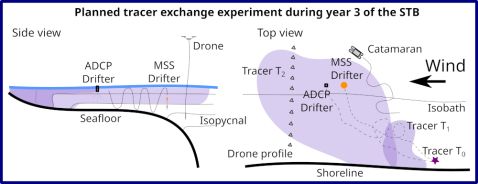
Workpackage 2 - Autonomous sampling
The coastal zone serves as a connector between the land and the open sea and represents an important exchange area for nutrients, pollutants, larval fish, invertebrates and microorganisms. The dynamics governing the circulation and mixing differ decidedly between the two areas, with the exchange processes showing a strong variability in space and time. To be able to link physical processes and their role in biogeochemistry and biodiversity requires a methodology to sample physical, geological and biogeochemical parameters in a harmonized way on dynamically relevant time and spatial scales. WP2 aims to tackle this challenge by designing a sampling system that combines “classical” variables as measured by i.e. CTD and ADCP with turbulence, microbiological diversity/activity, seafloor and subsurface heterogeneity and plankton communities. This is done in the first step at fixed positions, allowing a high temporal resolution and in a later step on autonomous devices like catamarans or drones, to yield a spatial picture. This novel approach helps to understand the impact of „hot moments“ like algae blooms, temporal anoxia or storm events on the coastal zone and the Baltic Sea.
Workpackage 2 will prove the following hypotheses:
- The water mass and tracer exchange are governed by the interaction between the wave influenced but well-mixed near coastal regime with the deeper, stratified open water. Exchange rates differ by orders of magnitude between short-term events with a strong spatial heterogeneity.
- Physical seafloor (and habitat) integrity in shallow waters is under higher pressure by anthropogenic activities and climate change compared to deeper basins waters.
- Automated high-resolution sampling and observation devices in combination with physical variables will improve the understanding of microbial diversity, function, dynamics and transport.
- Climate Warming, causing pronounced thermal stratification, promotes the invasion and establishment of new warm-adapted phytoplankton including Harmful Algal Bloom (HAB) species in the Baltic Sea and increases the potential of toxic bloom formation.
- Seed banks in shallow coastal waters will promote rapid recruitment and bloom initiation of local warm water HABs during Heat Waves.
- The significance of coastal sediments as reservoirs for the recruitment of key zooplankton of the Baltic Sea will change in response to short- and long-term environmental change (heatwaves, long-term warming).
